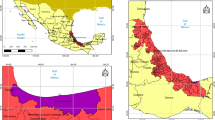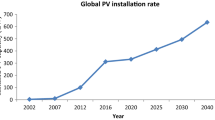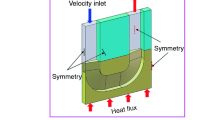Abstract
The present study attempts to use the methanol–silver nanofluid filled heat pipe heat exchanger and compares the effectiveness as well as the energy saving with pure methanol. A heat pipe heat exchanger has been tested in a test rig under steady-state conditions. The lengths of both the evaporator and the condenser sections of the heat exchanger were 700 mm, and its central adiabatic section had a length of 160 mm. The heat exchanger had 36 plate finned copper thermosyphons arranged in three rows. The inlet air temperature across the evaporator section was varied in the range of 33–43 °C while the inlet air temperature to the condenser section was nearly constant to be 13 °C. First, pure methanol was used as the working fluid with a fill ratio of 50 % of the evaporator section length, and then dilute dispersion of silver nanoparticles in methanol was employed as the working fluid. The nanofluid used in the present study is 20 nm diameter silver nanoparticles. The experiments were performed to compare the heat pipe heat exchanger effectiveness and energy saving, using nanofluid and pure methanol. The inlet air relative humidity across the evaporator section was varied between 35 and 80 %. The sensible effectiveness of the heat pipe heat exchanger obtained from experiments varied about 5–22 % for pure methanol and 9–32 % for methanol–silver nanofluid. Based on these experimental results, using methanol–silver nanofluid leads to energy saving around 8.8–31.5 % for cooling and 18–100 % for reheating the supply air stream in an air conditioning system.







Similar content being viewed by others
References
Akbarzadeh A, Wadowski T (1996) Heat pipe-based cooling systems for photovoltaic cells under concentrated solar radiation. Appl Therm Eng 16(1):81–87
Das SK, Choi SUS (2009) A review of heat transfer in nanofluids. Adv Heat Transf 41:81–197
Fan J, Wang L (2011) Heat conduction in nanofluids: structure–property correlation. Int J Heat Mass Transf 54(19–20):4349–4359
Godson L, Raja B, Mohan Lal D, Wongwises S (2010) Enhancement of heat transfer using nanofluids—an overview. Renew Sustain Energy Rev 14(2):629–641
Huminic G, Huminic A (2011) Heat transfer characteristics of a two-phase closed thermosyphons using nanofluids. Exp Therm Fluid Sci 35(3):550–557
Huminic G, Huminic A, Morjan I, Dumitrache F (2011) Experimental study of the thermal performance of thermosyphon heat pipe using iron oxide nanoparticles. Int J Heat Mass Transf 54(1–3):656–661
Kakaç S, Pramuanjaroenkij A (2009) Review of convective heat transfer enhancement with nanofluids. Int J Heat Mass Transf 52(13–14):3187–3196
Kang S, Wei W, Tsai S, Yang S (2006) Experimental investigation of silver nano-fluid on heat pipe thermal performance. Appl Therm Eng 26(17–18):2377–2382
Kang S, Wei W, Tsai S, Huang C (2009) Experimental investigation of nanofluids on sintered heat pipe thermal performance. Appl Therm Eng 29(5–6):973–979
Keblinski P, Phillpot SR, Choi SUS, Eastman JA (2002) Mechanisms of heat flow in suspensions of nano-sized particles (nanofluids). Int J Heat Mass Transf 45(4):855–863
Keblinski P, Eastman JA, Cahill D (2005) Nanofluids for thermal transport. Mater Today 8(6):36–44
Liu Z, Zhu Q (2011) Application of aqueous nanofluids in a horizontal mesh heat pipe. Energy Convers Manag 52(1):292–300
Liu Z, Li Y, Bao R (2011) Compositive effect of nanoparticle parameter on thermal performance of cylindrical micro-grooved heat pipe using nanofluids. Int J Therm Sci 50(4):558–568
Naphon P, Assadamongkol P, Borirak T (2008) Experimental investigation of titanium nanofluids on the heat pipe thermal efficiency. Int Commun Heat Mass Transf 35(10):1316–1319
Naphon P, Thongkum D, Assadamongkol P (2009) Heat pipe efficiency enhancement with refrigerant–nanoparticles mixtures. Energy Convers Manag 50(3):772–776
Noie SH (2005) Heat transfer characteristics of a two-phase closed thermosyphon. Appl Therm Eng 25(4):495–506
Noie SH, Zeinali Heris S, Kahani M, Nowee SM (2009) Heat transfer enhancement using Al2O3/water nanofluid in a two-phase closed thermosyphon. Int J Heat Fluid Flow 30(4):700–705
Noie-Baghban SH, Majideian GR (2000) Waste heat recovery using heat pipe heat exchanger (HPHE) for surgery rooms in hospitals. Appl Therm Eng 20(14):1271–1282
Parametthanuwat T, Rittidech S, Pattiya A (2010) A correlation to predict heat-transfer rates of a two-phase closed thermosyphon (TPCT) using silver nanofluid at normal operating conditions. Int J Heat Mass Transf 53(21–22):4960–4965
Qu J, Wu H, Cheng P (2010) Thermal performance of an oscillating heat pipe with Al2O3–water nanofluids. Int Commun Heat Mass Transf 37(2):111–115
Rahimi M, Asgary K, Jesri S (2010) Thermal characteristics of a resurfaced condenser and evaporator closed two-phase thermosyphon. Int Commun Heat Mass Transf 37(6):703–710
Shafahi M, Bianco V, Vafai K, Manca O (2010) An investigation of the thermal performance of cylindrical heat pipes using nanofluids. Int J Heat Mass Transf 53(1–3):376–383
Teng T, Hsu H, Mo H, Chen C (2010) Thermal efficiency of heat pipe with alumina nanofluid. J Alloy Compd 504:S380–S384
Trisaksri V, Wongwises S (2007) Critical review of heat transfer characteristics of nanofluids. Renew Sustain Energy Rev 11(3):512–523
Tsai CY, Chien HT, Ding PP, Chan B, Luh TY, Chen PH (2004) Effect of structural character of gold nanoparticles in nanofluid on heat pipe thermal performance. Mater Lett 58(9):1461–1465
Vafai K, Wang W (1992) Analysis of flow and heat transfer characteristics of an asymmetrical flat plate heat pipe. Int J Heat Mass Transf 35(9):2087–2099
Vasiliev LL (2008) Micro and miniature heat pipes—electronic component coolers. Appl Therm Eng 28(4):266–273
Wang B, Zhou L, Peng X (2003) A fractal model for predicting the effective thermal conductivity of liquid with suspension of nanoparticles. Int J Heat Mass Transf 46(14):2665–2672
Xue Q (2003) Model for effective thermal conductivity of nanofluids. Phys Lett A 307(5–6):313–317
Yau YH (2007a) Experimental thermal performance study of an inclined heat pipe heat exchanger operating in high humid tropical HVAC systems. Int J Refrig 30(7):1143–1152
Yau YH (2007b) Application of a heat pipe heat exchanger to dehumidification enhancement in a HVAC system for tropical climates—a baseline performance characteristics study. Int J Therm Sci 46(2):164–171
Zeinali Heris S, Etemad SGh, Nasr Esfahany M (2006) Experimental investigation of oxide nanofluids laminar flow convective heat transfer. Int Commun Heat Mass Transf 33(4):529–535
Zeinali Heris S, Nasr Esfahany M, Etemad SGh (2007) Experimental investigation of convective heat transfer of Al2O3/water nanofluid in circular tube. Int J Heat Fluid Flow 28(2):203–210
Acknowledgments
The authors also wish to extend their sincere gratitude to all who assisted in promoting the present work.
Author information
Authors and Affiliations
Corresponding author
Rights and permissions
About this article
Cite this article
Firouzfar, E., Soltanieh, M., Noie, S.H. et al. Investigation of heat pipe heat exchanger effectiveness and energy saving in air conditioning systems using silver nanofluid. Int. J. Environ. Sci. Technol. 9, 587–594 (2012). https://doi.org/10.1007/s13762-012-0051-9
Received:
Revised:
Accepted:
Published:
Issue Date:
DOI: https://doi.org/10.1007/s13762-012-0051-9




